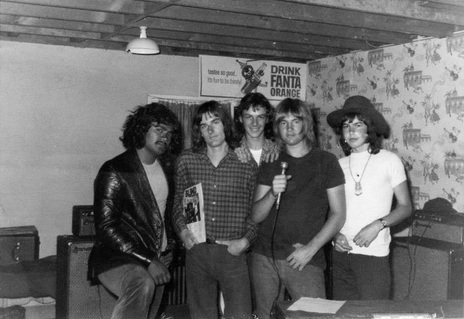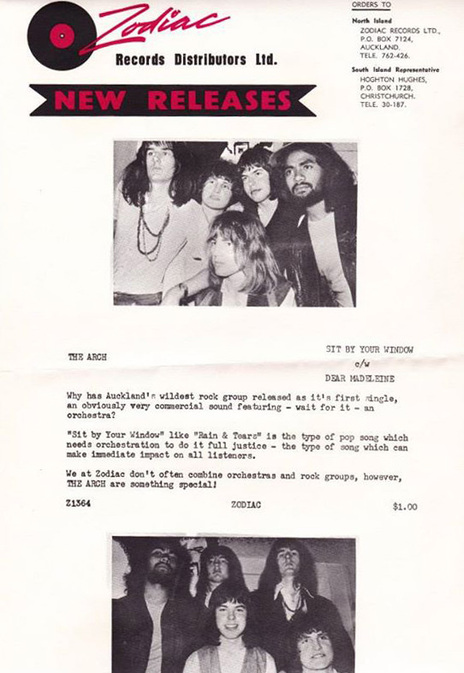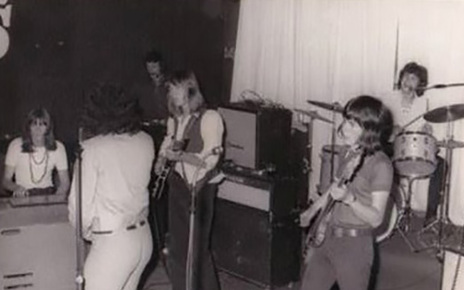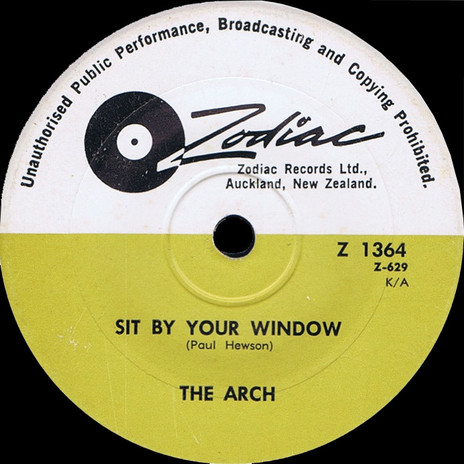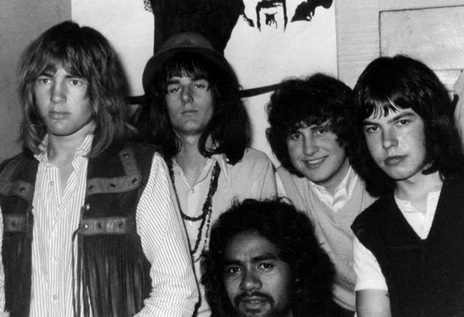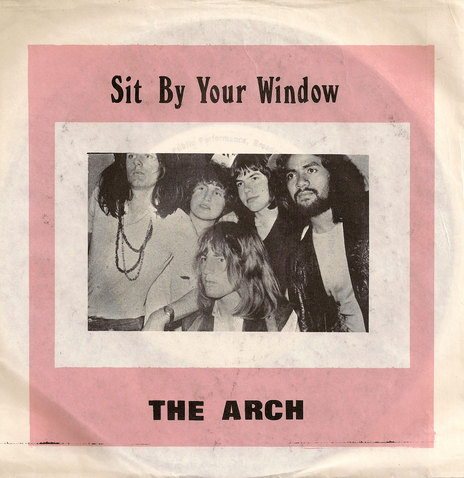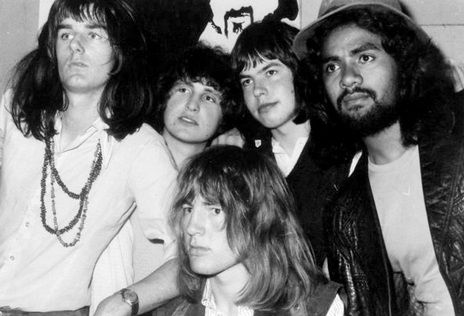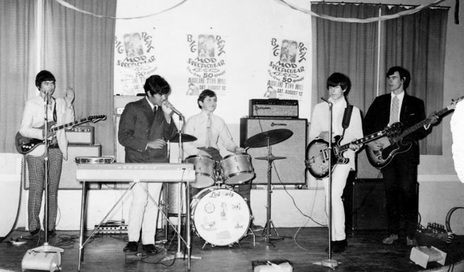The Arch came out of the Church of Jesus Christ of Latter-day Saints chapel in Croydon Road, Glen Eden, where Paul Hewson and his brother John Hewson met Māori soul singer Rangi Williams at the Mutual Improvement Association, or MIA, the club designed to strengthen the youth’s belief in Christ.
It didn’t take them long to outgrow the church and break into the Auckland club scene.
Originally named The Gargoyles and then The Marble Arch, it didn’t take them long to outgrow the church and break into the Auckland club scene at such venues as the Galaxie, the Top 20, the Bo Peep and the Forum in Takapuna.
In 1963, John Hewson received a guitar for his 13th birthday and had the Williams sisters at church show him some chords. He struggled to play them, but his younger brother Paul was a natural, quickly mastering the shapes and even tuning the instrument. Before long Paul and another Williams sibling, brother Rangi, began singing together at the church.
A couple of years later, Paneta Semu brought his guitar along to the MIA and talk turned to forming a band. Committed parents Jack and Dorothy Hewson bought a set of instruments and Paul appointed himself guitarist, Williams became lead singer and organist, John Hewson bass guitarist and by default Semu became drummer.
Paul christened them The Gargoyles and they practised at the chapel Saturday afternoons and evenings until the neighbours complained about the noise and Bishop Edward Hansen asked them to tone it down. They relocated to the Hewson home at 7 Mitchell Street, Blockhouse Bay, working up a repertoire of Cream, The Spencer Davis Group and The La De Da’s.
The Gargoyles started performing at church dances, sometimes at the invitation of older Samoan band The Harbour Lights. “We won all the church talent quests,” the late John Hewson revealed in a 2013 interview. “That’s where we started, where we had an audience and a stage. We won cakes, etc. When we got a bit wild, the church weren’t interested.
“The church gave The Gargoyles spots to play some songs and all of the young ones started coming. We got a whole night once and ended up getting chucked out because there were more young ones coming just for the dance.”
At their first paid gig, chaperoned by Jack and Dorothy Hewson in a Taupo hotel, they had about 12 songs. They played half of them in the first bracket, half in the second and then repeated them again in the third and fourth set. By then the audience had drunk enough not to notice or not to care and were singing along.
Lead guitarist David Pou joined and Paul renamed the band The Marble Arch. At this stage Paul and Rangi Williams were sharing the organ duties. They obtained a new drummer when Paneta Semu bowed out having heard Courtney Chapman play, but Chapman didn’t stay long after Peter Grattan met Paul Hewson in April 1967.
Following a two-year stint in Whangarei where he’d been drummer in Cliff & The Clan backing Maria Dallas and working with Larry’s Rebels, Gray Bartlett, Sandy Edmonds and The La De Da’s, Grattan had a job as promotions assistant at Harry M. Miller’s Auckland base.
In the words of Dorothy Hewson “a very confident boy,” Grattan refused to use the Hewsons’ Japanese drums and played his own champagne sparkle Ludwig kit as he breezed through an audition with The Marble Arch. He instigated a name change to The Saint Ludwig Group and the band set up their own dance at the Mt Roskill War Memorial Hall with their parents running security and the door, and 300 teens in attendance.
Within weeks, they had reverted to The Marble Arch and scored spots at the Galaxie. “By the time we’d pulled the plug at the church we’d got quite good at what we were doing,” John Hewson said. “We moved to the Galaxie and all the young Mormons started coming to the nightclub!” But a couple of months later Grattan quit and the band floundered.
Meanwhile in Henderson, The Plague were putting on their own dances in local halls. Formed in 1966 by Richard Paulger and 15-year-old guitar nut Rob Maginley, The Plague were completed by Ken Thomas and singer Martin Round. Paulger and Thomas would alternate between bass and drums.
One night when The Plague and The Marble Arch crossed paths, The Plague were impressed by Paul Hewson’s organ playing and the fact that he owned his own instrument. They invited Paul to join, but he said he would only do so if his bass-playing brother John could come too.
As Richard Paulger had “met a girl and got a motorbike” he happily moved aside. No sooner had the Hewson brothers come in and Paul had talked the others into renaming the band The Marble Arch. The line-up was Paul Hewson (organ), John Hewson (bass), Rob Maginley (guitar), Martin Round (vocals) and Ken Thomas (drums).
They performed at birthday parties and weddings as well as slots at the Galaxie and the Top 20, where Rangi Williams would do a few numbers. Their part-time manager got them a half-hour session at Eldred Stebbing’s basement studio, where they cut Jimi Hendrix’s ‘Purple Haze’ and The Young Rascals’ ‘I Ain’t Gonna Eat Out My Heart Anymore’ and ‘Baby, Let’s Wait’.
The resulting acetate was the death knell for Martin Round’s tenure in the band. Even by his own admission, he was no match for the versatile Williams, who was back in time for the Battle of the Bands at the Auckland Town Hall in August 1967 where he nailed the vocal and distinct organ solo as The Marble Arch performed Procol Harum’s ‘A Whiter Shade Of Pale’.
Early the next year, John Hewson quit and The Marble Arch again shut down. He didn’t get on with guitarist Rob Maginley and wasn’t happy with the drug and drink culture circling around the club scene. “It was coming in with alcohol and then marijuana and some of them were hitting other stuff. I thought, ‘If this is where it’s going, I’m outta here,’” he said in 2013.
Maginley formed Dream with his old Plague mates Richard Paulger and then Ken Thomas on drums, organist Paddy Gibbons and ex-Regional Authority bass guitarist Chris “Noddy” Dawson. They folded when Bo Peep venue boss and professional wrestler Dave Henderson was unimpressed by their succession of singers. Maginley and Dawson recruited Paul Hewson and Rangi Williams and re-formed The Marble Arch, quickly shortening the name to The Arch.
Williams was much more to Henderson’s liking and they quickly picked up work at the Bo Peep and the Galaxie. They auditioned drummer Ray Archer who had been overawed by their rendition of ‘A Whiter Shade Of Pale’ at the previous Battle of the Bands.
“They were fucking amazing on that big stage at the Town Hall,” Archer recalled in 2013. “Some months later they rang up, ‘We’ve heard you can drum.’ They wanted someone who could drum really fast. We went through a few songs at Paul’s house and I was in the band.”
Soon they were working six nights a week, but as Williams and Hewson were still faithful to their Mormon beliefs the band were unable to play the Sunday Showcase at the Galaxie. Alcohol, drugs, coffee and tea were against the rules but once Hewson started drinking alcohol, Williams followed.
“Paul was the more devout of the two, but he finally relented and Rangi went along with it,” bass guitarist Chris Dawson remembered. “He discovered alcohol but was against drugs of any kind. Although we were big Doors fans and played a lot of their songs, Paul didn’t like Jim Morrison’s drug-fuelled antics.”
Their combination of the newly discovered Doors and soul singers like Wilson Pickett and Otis Redding and Williams’ ability to pull off both styles gave The Arch a unique repertoire. They moved to a residency at the Forum in Takapuna, where they came under the wing of Australian-born promoter Ross Foster.
Notoriously miserly, Foster would stand over the band ensuring they ordered no more than one egg for breakfast in the hotel.
He acquired a Kombi van and trailer and got them work out of town in Otorohanga, Rotorua and up north with former Troubled Minds singer and star of Happen Inn Dick Roberts or Australian singer Larry Casey. One late-night trip on a metal road, they watched in horror while sparks flew as one of their wheels overtook them. Foster just managed to control the vehicle before it went over a sheer drop.
Notoriously miserly, Foster would stand over the band ensuring they ordered no more than one egg for breakfast in the hotel. No wonder he was nicknamed Ross Forehead and teased mercilessly by The Arch, who on another occasion set what little hair he had alight while he was driving. The relationship ended when the band were caught drinking on stage at the Forum and were sacked.
They returned to Eldred Stebbing’s studio in March 1969, recording The Turtles’ ‘Elenore’, Deep Purple’s ‘Kentucky Woman’ and Otis Redding’s ‘Your One and Only Man’ and ‘I’ve Been Loving You Too Long’. Stebbing liked what he heard and booked them in to record a single.
When they returned it was with two Paul Hewson songs they had worked up especially. Although the 16-year-old Hewson already had quite a collection of his own songs, ‘Sit By Your Window’ and ‘Dear Madeleine’ were the first two he presented to the band.
Sung by Rangi Williams, ‘Sit By Your Window’ was a ballad reminiscent of The Left Banke’s ‘Walk Away Renee’ while Hewson performed the up-tempo pop of ‘Dear Madeleine’, allowing Williams a rave-up ad-lib outro. For whatever reason, Stebbing did nothing with the recordings.
After a well-received Iron-Butterfly-and-Doors-heavy set at Redwood 70, The Arch started picking up work at Aubrey’s and the Oriental. Introduced by Pete Sinclair, they were the first band featured on the New Zealand Broadcasting Corporation feature Redwood 70, performing The Doors’ ‘Do It’.
Archer left later in the year and Hewson tried to get something going with Killing Floor guitarist Henry Jackson. Former Marble Arch drummer Peter Grattan, who had been playing with Disraeli Gears when they had double-billed with The Arch at the Forum, rang Chris Dawson and suggested he take Archer’s place and the band continue.
As suspected, once The Arch were working again at the Bo Peep, Hewson returned. Following a period as stock controller at Pye/RCA/MCA Records, Grattan was a sometime tech at Eldred Stebbing’s studio and convinced him to have The Arch complete the vocals on the recordings from a year previous and put out a single.
With a string section overdubbed on ‘Sit By Your Window’, the Zodiac press release compared the track to The Hi-Revving Tongues’ August 1969 hit for the label. “‘Sit By Your Window’ – like ‘Rain And Tears’ – is the type of pop song which needs orchestration to do it full justice,” it read. Despite continuing, “The Arch are something special,” it is thought that only 100 copies of the single were pressed. The band never performed the songs live.
Before the year was up Grattan had departed to play with guitarist Peter Posa in Australia and Rangi Williams had moved to drums. They had started smoking marijuana and took plenty of it with them when they played at Waihi Beach during the summer of 1970 and 71.
Early in the new year, Don Lylian offered them the residency at Aubrey’s and they changed their name to Freedom Express for the occasion. Soon they would try LSD, Paul Hewson would depart and members of The Hi-Revving Tongues and Space Farm would come through, but that’s a whole other trip.
